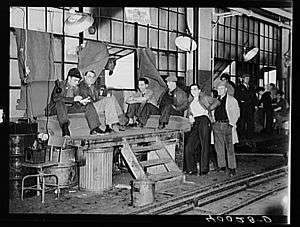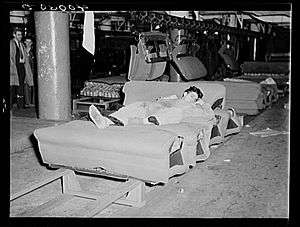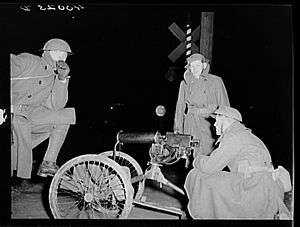Flint sit-down strike
| Flint sit-down strike | |||
|---|---|---|---|
 Sit-down strikers guarding window entrance to Fisher body plant number three. Photo by Sheldon Dick, 1937. | |||
| Date | December 30, 1936 - February 11, 1937 | ||
| Location | Flint, Michigan | ||
| Result | Recognition of the UAW | ||
| Parties to the civil conflict | |||
|
| |||
The 1936–1937 Flint sit-down strike against General Motors (also known as the General Motors sit-down strike, the great GM sit-down strike, and other variants) changed the United Automobile Workers (UAW) from a collection of isolated locals on the fringes of the industry into a major labor union and led to the unionization of the domestic United States automobile industry.
Background
The UAW had only been formed in 1935 and held its first convention in 1936. Shortly thereafter the union decided that it could not survive by piecemeal organizing campaigns at smaller plants, as it had in the past, but that it could organize the automobile industry only by going after its biggest and most powerful employer, General Motors Corporation, focusing on GM's production complex in Flint, Michigan.
Organizing Flint was a difficult and dangerous plan. GM controlled city politics in Flint and kept a close eye on outsiders. As Wyndham Mortimer, the UAW officer put in charge of the organizing campaign in Flint, recalled, when he visited Flint in 1936 he received a telephone call within a few minutes of checking into his hotel from an anonymous caller telling him to get back where he came from if he didn't "want to be carried out in a wooden box".
GM also maintained an extensive network of spies throughout its plants. Mortimer concluded after talking to Flint autoworkers that the existing locals, which had only 122 members out of 45,000 autoworkers in Flint, were riddled with spies. Accordingly, he decided that the only safe way to organize Flint was simply to bypass those locals. Mortimer, Eric Branoff, Roy Reuther, Henry Kraus, and Ralph Dale began meeting with Flint autoworkers in their homes, keeping the names of new members a closely guarded secret from others in Flint and in UAW headquarters.
As the UAW studied its target it discovered that GM had only two factories that produced the dies from which car body components were stamped: one in Flint that produced the parts for Buicks, Pontiacs and Oldsmobiles and another in Cleveland that produced Chevrolet parts. The union planned to strike these plants after the New Year, when Frank Murphy would become Governor of Michigan.
The strike

Events forced the union to accelerate its plans, however, when the workers at Cleveland's Fisher body plant went on strike on December 30, 1936 due to two brothers being fired from the assembly line. The UAW immediately announced that it would not settle the Cleveland strike until it reached a national agreement with GM covering all of its plants. At the same time the union made plans to shut down Fisher #1 in Flint. Genora Johnson Dollinger was one of the main organizers and protester for the flint sit-down. On the day of December 30, 1936, at 8:00, the Union learned that GM was planning to move the dies out of Fisher #1. Travis immediately called a meeting at lunchtime at the union hall across the street from the plant, explained the situation, then sent the members across the street to occupy the plant. The Flint sit-down strike began.[1]
In a conventional strike the union takes its members outside the plant and attempts to prevent the employer from operating by discouraging other employees from entering. In a sit-down strike, the workers physically occupy the plant, keeping management and others out. By remaining inside the factory rather than picketing outside of it, striking workers prevented owners from hiring strikebreakers to take their jobs and resume production.
The Flint sit-down strikers set up their own civil system within the strike. A mayor and other civic officials were elected by the workers to maintain order within the plant. Departments included Organized Recreation, Information, Postal Service and Sanitation. All rules were enforced by what was called a "Kangaroo Court" by the workers. Any person who broke the rules was given a trial and punishments ranged from washing dishes to in the most extreme cases being expelled from the plant. It was important for the strikers to maintain order in the plant for Governor would intervene with the National Guard should property damage occur. In addition to maintaining order the civic government also insured a steady stream of supplies from friendly vendors outside the plant. Most of the meals for the approximately 2,000 were provided to the workers free of charge by a diner across the street.[2]
Resistance

The police, armed with guns and tear gas, attempted to enter the Fisher Body 2 plant on January 11, 1937. The strikers inside the plant pelted them with hinges, bottles, and bolts, led by Bob Travis and Rob Reather. They were able to withstand several waves of attack, eventually ending the standoff. The strikers dubbed this "The Battle of Bulls Run", a mocking reference to the police ("bulls"). Fourteen strikers were injured by gunfire during the battle.
At the time, Vice President John Nance Garner supported federal intervention to break up the Flint Strike, but this idea was rejected by President Franklin D. Roosevelt. The president urged GM to distinguish a union so the plants could re-open.
GM obtained a second injunction against the strike on February 1, 1937. The union not only ignored the order, but spread the strike to Chevrolet Plant #4. To avoid tipping its hand, the union let it be known in the hours before the move that it intended to go after another plant in the complex, only changing directions at the last minute. GM, tipped off by an informant within the UAW, was ready and waiting for the union at the other plant and caught completely off guard at Plant #4. The strike ended after 44 days.
That development forced GM to bargain with the union. John L. Lewis, President of the United Mine Workers and founder and leader of the Congress of Industrial Organizations, spoke for the UAW in those negotiations; UAW President Homer Martin was sent on a speaking tour to keep him out of the way. GM's representatives refused to be in the same room as the UAW's, so Governor Frank Murphy acted as courier and intermediary between the two groups. Governor Murphy sent in the U.S. National Guard, not to evict the strikers, but rather to protect them from the police and corporate strike-breakers. The two parties finally reached agreement on February 11, 1937 on a one-page agreement that recognized the UAW as the exclusive bargaining representative for GM's employees who were members of the union for the next six months.[3]
Conclusion
As short as this agreement was, it gave the UAW instant legitimacy.[1] The workers there also got a 5% increase in pay and were allowed to talk during lunch. The UAW capitalized on that opportunity, signing up 100,000 GM employees and building the union's strength through grievance strikes at GM plants throughout the country. Several participants in the strike, including Charles I. Krause, went on to greater prominence within the union. Other notable participants in the sit-down strike were future D-Day hero and Greco-Roman wrestling champion Dean Rockwell, labor leader and future UAW president Walter Reuther, and the uncle of documentary filmmaker Michael Moore, whose debut feature Roger & Me contains a clip from the strike.
In the next year the UAW saw its membership grow from 30,000 to 500,000 members. Members came joined from other car manufacturers such as Ford causing the entire industry to rapidly unionize. As later noted by the BBC, "the strike was heard 'round the world".[4]
See also
- With Babies and Banners: Story of the Women's Emergency Brigade, a 1979 documentary film
Footnotes
- 1 2 Baulch, Vivian M.; Zacharias, Patricia (June 23, 1997). "Rearview Mirror: The historic 1936-37 Flint auto plant strikes". Detroit, Michigan: Detroit News. Retrieved June 11, 2011.
- ↑ Zinn, Retrieved 16 December 2013.
- ↑ Bak, Richard (September 2008). "(Frank) Murphy's Law". Hour Detroit. Retrieved June 9, 2012.
- ↑ BBC, "The 1936 - 37 Flint, Michigan Sit-Down Strike", Retrieved 6 February 2012.
Further reading
- Armstrong, Rudy, The History of UAW Local 659: we make our own history, Flint, Mich., UAW Local 659, 1993.
- Bak, Richard (September 2008). "(Frank) Murphy's Law". Hour Detroit. Retrieved June 9, 2012.
- Barnard, John (2004). American Vanguard: The United Auto Workers During the Reuther Years, 1935-1970. Detroit: Wayne State University Press. ISBN 0-8143-2947-0.
- Bernstein, Irving (1970 (Originally published 1969)). The Turbulent Years: A History of the American Worker, 1933-1941. Boston: Houghton-Mifflin Co. ISBN 0-395-11778-X. Check date values in:
|date=(help) - Fine, Sidney. "The General Motors Sit-Down Strike: A Re-examination,"American Historical Review (1965) 70#3 pp. 691–71 in JSTOR
- Fine, Sidney (1969). Sit-Down: The General Motors Strike of 1936-1937. Ann Arbor, Michigan: University of Michigan Press. ISBN 978-0-472-32948-9.
- Galenson, Walter (1960). The CIO Challenge to the AFL: A History of the American Labor Movement, 1935-1941. Cambridge, Massachusetts: Harvard University Press. ISBN 0-674-13150-9.
- Kraus, Henry (1993). Heroes of Unwritten Story: The UAW, 1934-39. Urbana, Illinois: University of Illinois Press. ISBN 0-252-06397-X.
- Kraus, Henry (1985). The Many and the Few: A Chronicle of the Dynamic Auto Workers.. Urbana, Illinois: University of Illinois Press. ISBN 0-252-01199-6.
- Murray, Joshua; Schwartz, Michael (2015). "Moral Economy, Structural Leverage, and Organizational Efficacy: Class Formation and the Great FlintSit-DownStrike,1936–1937." (PDF). Critical Historical Studies(Journal): 219–259.
- West, Kenneth B. (1986). "On the Line': Rank and File Reminiscences of Working Conditions and the General Motors Sit-down Strike of 1936-37". Michigan Historical Review: 57–82. JSTOR 20173072. at JSTOR
- Zieger, Robert (1997). The CIO, 1935-1955 (Reprint ed.). Chapel Hill, N.C: University of North Carolina Press. ISBN 0-8078-4630-9.
External links
| Wikimedia Commons has media related to Flint Sit-Down Strike. |
- Reuther Library Subject Focus: Remembering the Flint Sit-Down from the Walter P. Reuther Library
- Audio interviews with workers and other actors in the strike.
- Genora (Johnson) Dollinger Remembers the 1936-37 General Motors Sit-Down Strike
- Baulch, Vivian M.; Zacharias, Patricia (June 23, 1997). "Rearview Mirror: The historic 1936-37 Flint auto plant strikes". Detroit, Michigan: Detroit News. (PDF)
- Walter Linder. "How Industrial Unionism Was Won: The Great Flint Sit-Down Strike Against GM 1936-37"
- The Flint sit-down strike, 1936-1937 - Jeremy Brecher